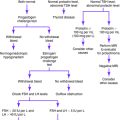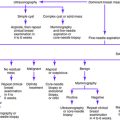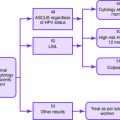Chapter 18 HIRSUTISM
Hirsutism is defined as the presence of excessive coarse terminal hair in a pattern not normal in women in areas such as the face, chest, or upper abdomen. This disorder is a sign of increased androgen action on hair follicles, which may result from increased levels of endogenous or exogenous androgens or from increased sensitivity of hair follicles to normal levels of circulating androgens.
Key Physical Findings
Suggested Work-Up
| Measurement of serum testosterone, serum 17α-hydroxyprogesterone, and dehydroepiandrosterone sulfate (DHEAS) | To evaluate for ovarian and adrenal tumors and adult-onset adrenal hyperplasia |
| Serum prolactin measurement | To evaluate for pituitary tumors |
| Thyroid-stimulating hormone (TSH) measurement | To evaluate for thyroid dysfunction |
| Fasting serum glucose measurement | To evaluate for insulin resistance in patients suspected of having polycystic ovary syndrome |
Additional Work-Up
| Adrenocorticotropic hormone (ACTH) stimulation test | When Cushing syndrome or adult-onset congenital adrenal hyperplasia is suspected |
| Glucose tolerance test | In patients with suspected polycystic ovary syndrome with elevated fasting serum glucose levels |
| CT scanning of the abdomen and pelvis | To assess the adrenal glands and ovaries in patients whose history, physical examination findings, or laboratory evaluation results are suggestive of the presence of a virilizing tumor |
Gilchrist VJ, Hecht BR. A practical approach to hirsutism. Am Fam Physician. 1995;52:1837-1846.
Hunter MH, Carek PJ. Evaluation and treatment of women with hirsutism. Am Fam Physician. 2003;67:2565-2572.
Leung AK, Robson WL. Hirsutism. Int J Dermatol. 1993;32:773-777.
Plouffe L. Disorders of excessive hair growth in the adolescent. Obstet Gynecol Clin. 2000;27:79-99.
Redmond GP, Bergfeld WF. Diagnostic approach to androgen disorders in women: acne, hirsutism, and alopecia. Cleve Clin J Med. 1990;57:423-427.
Speroff L, Glass RH, Kase NG, editors. Clinical Gynecologic Endocrinology and Infertility, 6th. Baltimore: Lippincott Williams & Wilkins. 1999:529-556.





